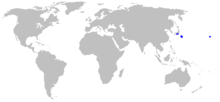Viper dogfish
| Viper dogfish | ||||||||||||
|---|---|---|---|---|---|---|---|---|---|---|---|---|

Viper dogfish ( Trigonognathus kabeyai ) |
||||||||||||
| Systematics | ||||||||||||
|
||||||||||||
| Scientific name of the genus | ||||||||||||
| Trigonognathus | ||||||||||||
| Mochizuki & Ohe , 1990 | ||||||||||||
| Scientific name of the species | ||||||||||||
| Trigonognathus kabeyai | ||||||||||||
| Mochizuki & Ohe , 1990 |
The viper dogfish ( Trigonognathus kabeyai ) is the only species of the genus Trigonognathus within the lantern sharks (subfamily Etmopterinae, also classified as the family Etmopteridae). The small shark reaches a body length of about 54 centimeters and occurs in the deep sea in the central Pacific Hawaii and in the North Pacific off the Japanese coast.
Appearance and characteristics
The viper dogfish is a small shark with a maximum body length of 54 centimeters. It has an elongated body typical of the lantern sharks with a long and at the same time wide and flattened head. This is noticeably "snake-like" with large eyes and very long, fang-like, curved and pointed teeth. Both jaws are very flexible. The body color is brown on the top and black on the belly. It also has the luminous organs typical of lantern sharks , which are dark markings on the belly and on the tail fin stalk.
It has no anal fin and two dorsal fins with the order-typical spines in front of the dorsal fins, which are strong and pointed. The first dorsal fin begins far behind the end of the pectoral fins and is about the same size as the second dorsal fin. Like all species in the family, the animals have five gill slits and an injection hole behind the eye, which in this species is large and diagonally slit-shaped.
distribution
The distribution area of this species lies in the central to the north Pacific, the exact extent is still unknown. It is regularly caught as bycatch off the coast of Japan , and one individual was caught in the central Pacific off Hawaii .
Way of life
The viper dogfish lives near the coast above the continental shelf and occurs at depths of 330 to 360 meters. Like other sharks, it feeds in a predatory manner, probably mainly on comparatively large fish, crustaceans and molluscs, which are swallowed whole, due to its fang-like teeth and the very wide-opening jaws.
There are no data or observations about his way of life. Like other species of the order, it is very likely viviparous ( ovoviviparous ), further information on reproduction is missing.
Danger
Due to a lack of data, the viper dogfish is not assigned to any hazard category on the IUCN Red List . Due to its limited range and the rare finds, it is regarded as a rare deep-sea shark and, according to the IUCN, should be examined specifically for a decrease in the event of an increase in fishing pressure in its area of distribution. It is irrelevant as a food fish and is therefore not fished specifically. However, it is occasionally caught as bycatch in bottom-net fisheries .
supporting documents
- ↑ a b Kenji Mochizuki, Fumio Ohe: Trigonognathus kabeyai, a new genus and species of the squalid sharks from Japan. (PDF; 1.4 MB) In: Japanese Journal of Ichthyology. 36 (4), 1990, pp. 385-390.
- ^ A b Leonard Compagno, Marc Dando, Sarah Fowler: Sharks of the World. Princeton University Press, Princeton 2004, ISBN 978-0-691-12072-0 , page 90
- ↑ a b Trigonognathus kabeyai in the endangered Red List species the IUCN 2009 Posted by: K. Yano, 2004. Retrieved on October 19 of 2009.
Web links
- Viper dogfish on Fishbase.org (English)
literature
- Leonard Compagno , Marc Dando, Sarah Fowler: Sharks of the World. Princeton University Press , Princeton 2004, ISBN 978-0-691-12072-0 (Princeton Field Guides), p. 111
